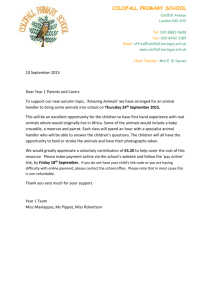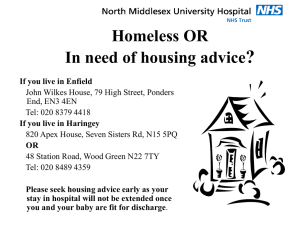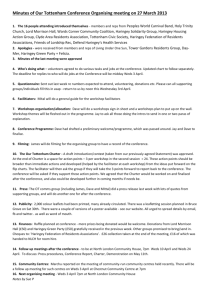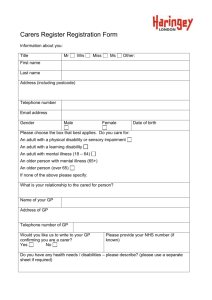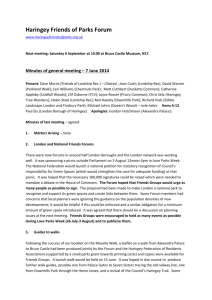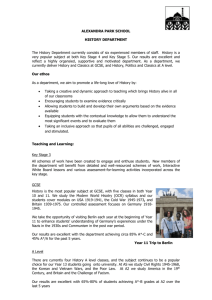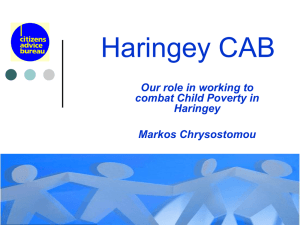Guidelines for Organisers of Events in Haringey
advertisement
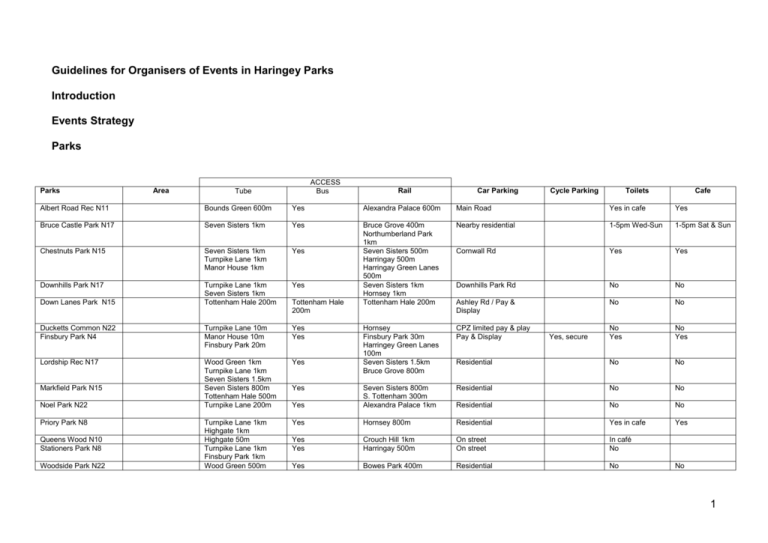
Guidelines for Organisers of Events in Haringey Parks Introduction Events Strategy Parks Parks Area ACCESS Bus Tube Rail Car Parking Cycle Parking Toilets Cafe Albert Road Rec N11 Bounds Green 600m Yes Alexandra Palace 600m Main Road Yes in cafe Yes Bruce Castle Park N17 Seven Sisters 1km Yes Nearby residential 1-5pm Wed-Sun 1-5pm Sat & Sun Chestnuts Park N15 Seven Sisters 1km Turnpike Lane 1km Manor House 1km Yes Cornwall Rd Yes Yes Downhills Park N17 Turnpike Lane 1km Seven Sisters 1km Tottenham Hale 200m Yes Bruce Grove 400m Northumberland Park 1km Seven Sisters 500m Harringay 500m Harringay Green Lanes 500m Seven Sisters 1km Hornsey 1km Tottenham Hale 200m Downhills Park Rd No No Ashley Rd / Pay & Display No No Ducketts Common N22 Finsbury Park N4 Turnpike Lane 10m Manor House 10m Finsbury Park 20m Yes Yes CPZ limited pay & play Pay & Display No Yes No Yes Lordship Rec N17 Wood Green 1km Turnpike Lane 1km Seven Sisters 1.5km Seven Sisters 800m Tottenham Hale 500m Turnpike Lane 200m Yes Hornsey Finsbury Park 30m Harringey Green Lanes 100m Seven Sisters 1.5km Bruce Grove 800m Residential No No Residential No No Yes Seven Sisters 800m S. Tottenham 300m Alexandra Palace 1km Residential No No Turnpike Lane 1km Highgate 1km Highgate 50m Turnpike Lane 1km Finsbury Park 1km Wood Green 500m Yes Hornsey 800m Residential Yes in cafe Yes Yes Yes Crouch Hill 1km Harringay 500m On street On street In café No Yes Bowes Park 400m Residential No Down Lanes Park N15 Markfield Park N15 Noel Park N22 Priory Park N8 Queens Wood N10 Stationers Park N8 Woodside Park N22 Tottenham Hale 200m Yes Yes, secure No 1 Haringey Parks Events Guide Introduction This guide has been written for events organisers who would like to hold an event in a Haringey Park. Please note that Highgate Wood and Alexandra Park are not operated by Haringey Parks. If your event is small, for example, a picnic, fun run or walk with less than a hundred people attending please see the Small Events Guide. The following information is provided in the guide: Contact Haringey’s Approach to Events Park Venues Licensing Event pre-planning How to apply for an event General Park Rules Risk Assessment Fees and Charges Next Steps Filming in Haringey Contacts Haringey’s Approach to Events There are 382.86 hectares of public open space in Haringey. The majority of open space is owned and managed by Haringey Council. However, three of the larger spaces – Alexandra Park, Lea Valley Regional Park and Highgate Wood – are managed by other organisations. 85% of residents visit Haringey Parks each year. Parks provide social and cultural opportunities for communities to organise and attend large and small events, meet people, enjoy family and group outings, visit play facilities, walk and cycle, and play sport together. This can generate and provide a focus for community cohesion. The Open Space Strategy 2006 identified a range of key issues which need to be addressed in order to improve local people’s ability to obtain a greater level of enjoyment and benefit from open space. One of these is: “Developing the role of open space for cultural experiences and activities including events, festivals and as spaces to engage with and interpret the historic environment”. This led to the strategic objective: “To develop and promote an increased range of opportunities for people to enjoy cultural experiences and activities”. This events guide describes those parks managed by Haringey, where there is a history of events and where parks are deemed suitable for general event enquiries. Other smaller parks and open spaces may still hold events and enquiries are welcomed. 2 The Events Guide has been produced to assist event organisers put together a plan to hold a safe and successful event in a park. Applicants need to understand that under English Law an event is considered as work. Therefore, event organisers have a legal duty to comply with the Health & Safety at Work Act 1974 and all associated EC directives. Please do not be put off by this, the Event Guide lists the areas you need to consider when planning an event. Work through the areas and they will help you plan a safe and successful event. Events in our parks can sometimes raise money to help pay for the upkeep and improvement of parks. However, we recognise that there needs to be a careful balance maintained between events and their impact on the parks themselves, the enjoyment of the parks by local people and any impact on residents living close to parks. The events strategy below sets out how the balance between events, park visitors & its neighbours and the conservation of the parks landscapes will be managed. The aims are: To ensure that events held in our parks are well managed so as to minimise their impact on the parks’ landscape, other parks visitors and its neighbours To allow access to our parks for a range of community events To develop a programme of neutral impact events and activities to take place within our parks To hold a programme of commercial events whose income enables us to continue to maintain and improve our parks In respective of the above excluding funfairs, Finsbury Park N4 is limited to 5 major events per year. Haringey Parks are provided for the enjoyment of all. An overriding approach when assessing an event application is the appropriateness of the event for the setting in which it is proposed to take place. With this in mind, the following events would not normally be considered: - Religious events including meetings, outreach ministry crusades or evangelical gatherings - Boot fairs and related product /service selling (except farmers / xmas / theme markets) Funfairs There is no limit to the number of days or period for Funfairs permitted to operate in Haringey Parks and Open Spaces. Market forces, the suitability of a particular site and the impact on the day to day park usage determine the number of funfairs and their duration. Since 2003 there have been 7 funfairs held per year with similar booking periods each year. Head of Parks approval is required for any new operator. The criteria used for assessing a new application includes: 3 references from other local authorities Current safety certification for all rides Membership of either the : Showman’s Guild of Great Britain, Society of independent Roundabout Proprietors, Amusement Catering Equipment Society, British Amusement Catering Trades association, 3 British Association of leisure parks, piers and attractions, National Association for Leisure industry Certification. Park Venues Finsbury Park Endymion Road N4 Finsbury Park was created by Act of Parliament and opened in 1869. A former forest in Roman times, the area was later used for hunting by London’s noblemen including Henry VIII. This large park is sited at the boundaries of three London boroughs: Haringey, Hackney and Islington is just 4 miles from the centre of London and takes less than 10 minutes by tube. A £5m Heritage Lottery funded makeover of the park was completed in 2006, featuring revitalised paths and gardens, boating lake, café & toilets and children’s play areas. The New River constructed in 1613 to provide water from Hertfordshire for London still flows through the park. A number of areas of the Park are suitable for large sporting, charitable and commercial events. There is a 400m floodlit athletics track with grass in-field, the reservoir field, (there is one underneath the grass), and other grassed areas for consideration for an event. The Park has a wide circular carriageway often used for walking events, fun runs and cycling events. The Park boasts excellent transport links with the Finsbury Park bus, rail, bus station adjacent to a main entrance. There is also a bookable secure cycle park. Kings Cross St Pancras is just two tube stops away. The park currently hosts funfairs at Easter, Whitsun and August Bank Holidays. Excluding funfairs the number of major events, is limited to 5 per year. Early booking is recommended. Bruce Castle Park & Museum Lordship Lane N17 Located near the Spurs football ground in Tottenham, this 16 acre park features a 16th century manor house now a Grade 1 listed building with its museum containing the local history archives. A former woodland and well known hunting ground was once owned by one of Henry VIII’s courtiers. One of the wives of the 2nd Lord Coleraine is said to haunt the building. The park itself has a tree trail taking visitors around trees thought to be 200 years old and one large oak that is 400 years old. The park can accommodate medium to large events in its central triangular grassed area. The nearest tube is Seven Sisters or the Bruce Grove rail station. Parking is free on local streets. The range of events that typically take place are: the Tottenham Carnival, arts days and picnics. 4 Downhills Park Downhills Park Road N17 This park has two distinct sections, a recreation ground for mainly casual football and other sports, and formal gardens and play areas. The park is popular with walkers with its circular route and cyclists making their way from Finsbury Park to the Lea Valley Park via the green ways route. Events here tend to be community based celebrating sports and the arts. Turnpike Lane tube station is a 10 minute walk. Ducketts Common Green Lanes N22 Ducketts Common has two distinct parts. One of these is three basketball courts which attract a great number of players arriving early afternoon and staying late. The other area situated some 50m away is a plain grassed area surrounded by trees and railings. The area is constantly busy as is situated by Green Lanes, so is not suitable for events needing to be away from traffic noise. The attraction here is the easy access, being adjacent to Turnpike Lane tube and bus station, and just off the main Wood Green shopping area. Ducketts Common is used for out-door basketball tournaments, whilst the grass area is used for funfairs, and gatherings where tube access is important. Chestnuts Park St Ann’s Road N15 Chestnuts Park has received a make over during 2008 improving play facilities and paths. The park benefits from a café and toilets. Main transport links are about 1m away and parking is limited, making this park most suitable for smaller events with school sports days, picnic and local fun days being popular. Priory Park Middle Lane N8 This is a busy park located in a residential area and popular for children’s parties in the Pavilion and picnics in the dog-free Philosopher’s Garden. There is a well-liked café, with paddling pool and nearby play area. There are good sized grass areas in the central part of the park where medium sized events can be held. Typical events have been steam fairs, road races, fun days and cycle fairs. Access is best by car, parking on local streets. Turnpike Lane & Highgate tube stations are both approx. 1 mile away, Hornsey rail station is a 10 minute walk. 5 Albert Road Recreation Ground Albert Road N22 Set in a residential area at the bottom of Muswell Hill and bordered by two schools. This is a popular local park with a café, tennis courts with coaching and play areas. The focus for events tends to be school sports based, as the grassed areas are used for football and cricket matches. Lordship Recreation Ground Lordship Lane N17 This large recreation ground has just commenced a series of major improvements to its play offering featuring a wooden adventurous play area, a popular skateboard and BMX area and floodlit multi-use games area. The central grassed area is large and slopes towards a brook and lake. Access is by bus & car though tube stations at Wood Green and Seven Sisters are respectively 10 and 15 minutes walk. Typical events here are football, basketball, and skateboard / bmx events. Running, cycling and walking events can be held using the circular paths. This park is bidding for lottery money to restore the culverted Old Moselle stream that passes through, upgrade the 1930s former model traffic area to a cycling centre for junior citizens, and revisit the park’s farm heritage with provision of a city farm. Markfield Park Crowland Road N15 Bordering the River Lee this park is in the process of a £3m improvement programme. There is a little known museum featuring a 100 year old steam beam engine once used in water treatment. Once the improvements have been completed, the park will have a café, toilets and new range of play facilities. Its flat central grassed area can be used for a range of small to medium sized events. The rail, tube and bus terminus at Tottenham Hale station is within 10 minutes walking distance. Down Lane Park Park View Road/Ashley Rd N17 A small park that serves for many as a short cut for the nearby Tottenham Hale bus, train and tube station. This park has a good sized flat grass area used for football in Winter. Small to medium sized events are suitable here and its transport links are excellent. Each year A funfair takes place here during the August Bank holiday. Licensing Under the Licensing Act 2003 a “Premises Licence” is required at events where there is a supply of alcohol, or where there is ‘regulated entertainment’. Outdoors ‘regulated entertainment’ includes: 6 - A performance of music Any playing of recorded music Performance of dance Performance of a play Where there is a supply of alcohol, or where there is ‘regulated entertainment’, as described above application for an Premises Licence must be made by the event organiser to the Haringey Licensing Section (see contact details below). Applicants are required to publicise their applications by placing a copy of the application at the venue for 28 days and in the local newspapers within 10 days of making the application. Thus, you are advised to allow a period of at least 6 weeks prior to the event for this process to occur. Where there is a supply of alcohol, or where there is ‘regulated entertainment’, as described above and the expected attendance is less than 500 at any one time, a simpler “Temporary Events Notice” is required from the Haringey Licensing Section. No public notices are needed for this licence. We advise that you apply at least 3 weeks prior to the event. Licence application forms with full guidance notes and charges can be found on line at: www.haringey.gov.uk/licensing Tel. 0208 489 5103 / 8232. email licensing@haringey.gov.uk Event Pre-planning Event organisers need to consider the feasibility of the idea before embarking on the detail needed in taking on an event: What – what kind of event are you planning and do you or those you intend to work with have the skills, knowledge, capacity and experience to host a safe and successful event? The application process will examine this fundamental requirement. This can be quite time consuming. Where - Choose a venue for the list above appropriate to the setting. Small events can be considered in smaller parks and open spaces not listed. Consider how your audience will get to the venue and can they park cars? Who – who are you targeting and how will they know you are holding this event? Will visitors have any special needs that you should consider? When – consider the time of year and the consequences of extreme weather conditions. Will the event need lighting at night? Will the event clash with another event that could affect attendance, for example, a football match at Spurs. Specialist Equipment – Will the event need specialist equipment like staging, sound, safety barriers, security? 7 How to apply for an event What you need to do: Telephone Parks Customer Care 020 8489 5662 or email. parkscustomercare@haringey.gov.uk and give an outline of what you want to do. The following list can be used to help you: Very brief description of event eg a fun run Which park When Expected attendance numbers Ticketed entry or open to all Who are you expecting and how you will attract them Equipment e.g. marquee, toilets, pa, catering What we will do: We will then advise you whether or not we would consider the event and send you an application pack. Application Pack This will contain: An Application Form, Events Guide, Event Process Guide, Event Safety Management Plan guide, Fees & Charges card, Safety Checklist, and our Terms and Conditions. Please note that all hirers must provide evidence of insurance. Small Events If you are holding a small event then please refer to the ‘Small Events Guide’. Typical examples of small events are: - A non-commercial organised run or walk with less than 100 participants - A picnic for less than 100 people - A community sports competition including a schools sports day - A performing arts event with an audience of less than 100 at any one time For all other events the sections of these guidelines apply. These include: - Concerts - Funfairs / circuses - Farmers markets - Large fun runs or walks (500 plus participants and spectators) - Festivals both sports and non-sports - Flower shows - Exhibitions - Large performing arts events (500 plus participants and spectators) - Any event that would need the involvement of the local authority or emergency services Timescale Please allow a minimum of: - 12 weeks from the time of your enquiry to the event date, - 6 weeks from the time of your enquiry for a Small Event. Events will be considered and allocated on a first come, first served basis. Allow 6 weeks to apply for a Premises Licence Allow 3 weeks to apply for a Temporary Event 8 Event application Complete the application form and return it with your Event Safety Management Plan. Unless you are a Haringey school / college you will also need to sign and return our Terms and Conditions document. Event Safety Management Plan At this stage this Event Safety Management Plan can be brief, but needs to demonstrate that the event organiser is planning a safe and successful event. The following list should be covered as far as they are applicable: Event Co-ordinator – in law events are considered as ‘work’ so this person has a legal duty under the Health & Safety at Work Act 1974 and any EC directives, and must comply with any licensing requirements. This person needs to be identified at an early stage. Event Team – establish an event team and agree responsibilities. Timescale – allow 12 weeks from enquiry to event date. For small events allow 6 weeks. Experience – discuss what event experience you have of putting on an event Health & Safety Policy and Arrangements – if you have 5 or more employees you are required to have a Health & Safety Policy and written arrangements stating how you will deal with health and safety issues. Community Events are exempt from this requirement, though the HSE recommend you consider adopting a framework. Licensing – is a Premises Licence or a Temporary Event Notice needed? Insurance – event organisers are required to hold a current insurance in respect of Public Liability with a minimum indemnity of £2 million and the Council reserves the right to increase this limit. Event insurance can be obtained from specialist event and exhibition agents. The event - What attractions are you planning for your event? What steps have you taken to ensure these will take place on the day as advertised? Attendance - How many people are you planning for? This is fundamental in terms of you assessing risk and gauging the level of provision of facilities/ accommodation. Site Plan - Consider the layout of the proposed venue and sketch out a basic plan, to cover access and exits, circulation routes, vehicle, toilets, catering, attractions, performance areas. This is only outline and is likely to change as the plan develops. Emergency Plan – a formal plan of how you will deal with any emergency situation that may arise. This plan should be the result of hazard spotting and assessing the risks involved with the event and compliance with the Health & Safety at Work Act 1974 and all associated EU directives. Please remember event organisers have a legal duty to comply. For example, assess your event for the risk of risk of fire, what hazards could cause a fire, that is, sources of ignition like electrics or flame, things that burn or give 9 off smoke like paper, fuel – gas or oil, and supply of oxygen lots of that you are outdoors. Controls in place – fire extinguishers, safe storage of paper, fuels Liaison – if planning a large event discuss your plans with the police, fire brigade, ambulance and first aid providers. Accidents – any accidents reported during set up, the event itself and post event should be recorded and investigated by a competent person. RIDDOR applies. Risk Assessment – you will need to provide and produce a copy upon request of an assessment of the hazards and risks associated with your event and ways in which you intend to reduce the level of risk where found. A guidance note and risk assessment form will be made available to you. The two principle risk assessments are: Fire Risk and Emergency evacuation. Temporary structures – meaning tents, marquees, stages, displays, equipment within. Safe erection and set down, fire risks, safe electrics, safe equipment, chemicals, fuels, catering. Tickets – will you be selling tickets or controlling entry by some other method into an enclosed event space or is the event open. If open how will you control numbers? Marketing / publicity - Who are you targeting and how will you attract them? Site set up – the Event Co-ordinator must inspect the grounds and determine safe sighting of event equipment, marquees, stage. Event control point – this should be marked on the site plan and should be staffed during set up, the event and set down. Mobiles phones, 2 way radios are useful aids. Monitoring – the event co-ordinator is required to monitor health & safety on site during the set up, immediately prior to the event, during the event itself and the set down Electrical installations – must be installed and removed by a competent electrician, with an appropriate test certificate issued to the co-ordinator. The inspection certificate must be produced for inspection upon request by local authority officers. Generators - must be diesel fuel only, placed in a position approved by the Council and have a 4.5kilo CO2 extinguisher provided. Cabling must be secured above head height, and placed so as to avoid trip hazard. LPG Containers – must be stored in open air, in a secure place away from public, and away from any source of ignition. Fire fighting appliances – a 9 litre water type fire extinguisher must be provided in each tent/marquee/caravan. Where there are electrics a CO2 extinguisher should also be provided Crowd Control – assess the need for this, consider use of crash barriers, stewarding, security. 10 Stewards – their main responsibility is crowd management. They are also there to assist police and other emergency services. Stewards should be readily identifiable, and provided in the ratio of at least one per 100 persons. Pop concerts may differ. Where there is a stage, sufficient stewards should be placed on the crowd barrier walkway to prevent incursion on stage and to rescue persons in need of first aid. Security – consider overnight risk to set up, need to employ professional security. Consider security of any cash collecting on site. Tents and Marquees – should conform to BS /EU standards and should be erected and set down by competent persons. All health and safety regulations and guidelines apply to their use including lighting, fire, refuse, exits. First Aid – first aid cover should be provided in accordance with the HSE Event Safety Guide. St. John’s Ambulance, the British Red Cross or the London Ambulance Service can advise. Toilets – the following tables should be used: Female - 1 WC per 100 Male - 1WC for up to 100 2 WCs for 101-500 3 WC fro 501-1000 1 WC extra for every 500 over plus 1.5 meters of urinal per 500 These figures can be reduced for shorter events as follows: 6 hours but less than 8 hours 80% 4 hours but less than 6 hours 75% Less than 4 hours 70% Wash hand basins: 1 per 5 WCs Wheelchair users - toilet provision should relate to the expected attendance of wheelchair users: - 1 WC with wash basin per 100 wheelchairs Drinking Water – this should be available at first aid posts, and where there is a stage in the pit areas. Water should be provided using a mains supply. If this is not possible, clean containers for potable water may be used. Special effects, pyrotechnics, out-door fireworks – these are not to be used or take place without the written approval of the Council and must be used in accordance with HSE guidance. Noise – the event co-ordinator shall ensure that no performance causes noise nuisance and should respond positively to requests to lower the sound level. Advice can be obtained on amplifiers’ power output, more power is not necessarily louder but the sound can carry further than needed. 11 Catering – at least three weeks prior to the event the event co-ordinator should supply the Haringey Food Safety Team (www.haringey.gov.uk and type ‘Food’ in the search box, or email. Enforcement@haringey.gov.uk - tel.020 8489 5558) with the names and addresses of all traders providing catering services. Caterers must adhere to fire safety and hot surface regulations and well as food hygiene guidelines. No glass containers or bottles are allowed on site. Metal cans are not permitted within a concert enclosure. Mobile caterers should comply with the Mobile Out-side Caterers Association. Refuse, litter – the event co-ordinator is responsible for ensuring that provision for the collection and storage of refuse occurs including caterers throughout the event and afterwards. The council will assess the level of provision proposed and may require a change to the proposal. Sign-posting – all emergency exits, toilets, drinking points, and first aid points should be clearly indicated Access / Egress for Emergency Services – the routes should be identified by signs and kept clear at all times. When called in emergency the event co-ordinator shall give the correct park access point for the emergency vehicle or appropriate open space in the event of a helicopter. Vehicles – All non-essential vehicles should be off-site 1 hour prior to event start. Following the end of the event the event co-ordinator shall check the site before allowing vehicles on site to set down. Traders shall be confined to agreed areas as shown on the site plan diagram. Vehicles should avoid reversing on site, unless assisted by a banks man. Contractors / Suppliers – vet for competence, see copies of safety policies and risk assessments of the relevant tasks being performed. Ensure you see a public liability insurance certificate. Provide contractors with copy of the event plan. Performers – professionals should have their own insurances and risk assessments. For amateurs discuss your requirements and theirs and ensure they will comply with Health and Safety and your event plan.. Lost Children – a suitably protected area shall be provided to keep lost children. Arrangements should be made to ensure the security, safety and return of children to their parent / guardian. Stewards need briefing as to the location of lost children. General site lighting – adequate artificial lighting should be provided to mark the event site and access/ egress routes after sunset. Contingency plans – consider implications of extreme weather conditions. Will the event be cancelled? What do you do if the main attraction fails to turn up? The list is not exhaustive and further advice can be obtained from the Health and Safety Executive publication: ‘The Event Safety Guide’ purchased from www.hsebooks.com or advice from the National Outdoor Event Association www.noea.org.uk . 12 How the Council will assess of your application The assessment criteria include: The suitability of the proposed park for this type of event. Does the event fit in with our Events Strategy and our general management aims for the Park Does the proposed event clash with another event in the park or in one of the neighbouring parks? Is there a major event taking place in the area at the same time? Ticket prices – are they reasonable? Is the event a public event? Will park conditions at that particular time of the year be conducive to holding events? Are the management arrangements, that is, the Event Safety Management Plan, satisfactory for this event? Are the Health and Safety arrangements, including the broad identification and management of risk, suitable and sufficient? Has enough time been given from submitting the proposal to the actual event date? Have previous events been managed satisfactorily by this organisation? Are the Parks Management and Local Ward Councillors, satisfied concerning the suitability, public safety and policing requirements for the event? Is the proposal for a one-off event or for a series of events? Does the frequency of events in the proposed location adversely affect park users, residents, local businesses, etc? Is there any planned maintenance or improvement works in the parks that will clash with this event? Approval We will write to you to tell you the result of your application. If your event is approved it will be conditional upon receiving the following: Return of the ‘indemnity form’, included in the approval letter Confirmation of the name and contact details of the Event Co-ordinator A developed Event Safety Management Plan Details of Health and Safety arrangements, including risk assessments and safe systems of work Site Plan Copy of your Public Liability insurance (except Haringey schools / colleges) Payment of ‘site bond’, effectively a returnable deposit subject to damage / uncollected refuse Payment of fees Pre-event meeting(s) A pre-event meeting will be arranged up to 3 weeks prior to the event start date. The meeting will attended by event representatives, parks management and possibly emergency services (depending on the scale of the event). Post Event site meeting This will take place at the first opportunity following the event, where the park’s manager will check the site for damage or refuse not picked up. Following this a costs bill to cover site damage or to cover litter collection may be sent or the site bond will be returned. Once payment of the costs bill has passed payment then the site bond will be repaid. 13 General Park Rules – see also: Terms and Conditions of Hire for Haringey and Open Spaces document – part of event pack All event organisers are expected to comply with the following: Provide the Park with evidence of your competence at organising events in the form of an Event Safety Management Plan, including a risk assessment. Please refer to the Haringey Parks Event Guide The organisers of most events must take out public liability insurance of £2,000,000 per incident Adhere to the route / Event Safety Management Plan / site plan agreed prior to the event Provide adequate stewards for the event. Runs, rides and walks will be expected to provide stewards at road crossings for example. Make arrangements for first aid. Put all litter into litter bins or take their waste away with them Event organisers will not be permitted to do any of the following: Affix items to trees Affix items railings, fences or other structure in the Park without permission Cook or barbecue any food in the park without written approval from the Council Light any fires, e.g. flaming torches Allow glass containers on site Let the event interfere with any other Park users or obstruct other park users Hand out literature other than from a fixed location (eg a stall) within an event, if so permitted Do bucket collections or similar, i.e. solicit donations from park visitors Balloon releases Pyrotechnics, lasers, smoke/fogs, fireworks displays without the written approval of the Council. Event Risk Assessment Guidance You have a legal duty to make a full assessment of the hazards and risks associated with your event and formulate a plan of how you will manage them. This section is intended to help you spot hazards that can be associated with out-door events and apply them to the HSE’s publication: ‘Five steps to risk assessment’ enclosed with your application pack. HSE 5 step Process Identify the hazards – defined as: “something that has the potential to cause harm” Decide who might be harmed and how, that is, the people at risk and the worst possible outcome Evaluate the risks and rate them as: High, Medium or Low, then seek ways to eliminate or at least reduce the risk. Record your findings by completing the risk assessment form in the HSE publication and implement actions. Review your assessment and update if necessary. 14 By planning with safety uppermost you should not have assessments that carry a ‘high’ risk as compliance with health and safety standards will automatically keep risk to a minimum. Step 1- Identify and list the Hazards: related to fire risk or fire evacuation that may impede safe exiting in emergency that may cause a slip, trip or fall chemicals including fuel, fumes or dust moving parts of machinery electrical installations& equipment manual handling high noise levels vehicles on site heating, lighting, ventilation risk from demonstrations or displays crowd intensity / crowd control amusement attractions temporary structures waste and litter Step 2 - Decide who might be harmed and how, consider the number of people at risk and the worst possible outcome Members of the public including special consideration of Disabled people, Children, Elderly people & Pregnant women Stewards Volunteers Contractors Vendor, exhibitors and performers Local residents Worst case scenarios: Death Serious injury Minor injury Step 3 - Evaluate the risks including establishing what control measures are in place, for example: fire extinguishers in place for fire, crash barriers in place for crowd control, equipment conforms with British Standards qualifications, instruction, training given rate the risks as: High Medium Low 15 then seek ways to eliminate or at least reduce the risk: Remove the hazard Prevent access to the hazard Reduce exposure to the hazard Use Personal Protective clothing Find a substitute activity / machine etc. Step 4 - Record your findings Use the HSE risk assessment form enclosed Step 5 - Review the findings should the nature of the event change, the risk assessment will need to be reviewed and updated Sharing information Should the risk assessment show any significant risks, you must provide information to all those affected, regarding the nature of the risk and the control measures to be implemented. Fees and Charges The fees and charges for events are divided into four bands: Commercial events – usually a figure based upon a rate per head All Other events – a rate card is available upon request Community small events – a rate card is available upon request Sports events & pitches Including school sports days - a rate card is available upon request NB Community rates are charged at the Parks Manager’s discretion Additional fees In addition to the event fees you will have to pay for waste and litter collection, and for any other costs we incur. Site Bond You will also have to pay a Site bond, which is returnable to you after successful completion of your event less any deduction for damage or additional costs we incur as a direct result of your event, such as additional litter clearance. Next Steps After reading these guidelines, draw up an Event Safety Management Plan. Please refer to the relevant sections in the Event Safety Management Plan guide above. This plan should inform you whether your idea for an event is feasible. The fees and charges rates can be obtained on request. If you wish to proceed contact the Parks Customer Services Officer who will send out an application pack. Complete an application form, and return it with the Event Safety Management Plan. There is no need to produce risk assessments at this stage. We will then assess your application as described above. 16 We will acknowledge receipt of your Event Safety Management Plan and application form, and give an indication of costs. Your application will be assessed as described above and we will contact you in due course. Filming in Haringey Haringey has its own Film Office and they are the single point of contact for filming on council property. All parks and open spaces are owned by Haringey Council, excepting Lea Valley Regional Park (Tottenham Marshes), Alexandra Park and Highgate Wood. Wedding photos are exempt. Please refer to the Small Events Guide and apply to the Customer Services Officer. Please contact the Haringey Film Office on: tel: 020 8489 6903, mob: 07976 457485 fax: 020 8489 2689, email: filmoffice@haringey.gov.uk, web: www.haringey.gov.uk/index/business/film.htm Contacts Customer Services Officer: Haringey Recreation Services Contract House Park View Road London N17 9AY tel. 0208 489 5662 email. parkscustomercare@haringey.go.uk web. www.haringey.gov.uk then type ‘events in parks’ in the search box . Haringey Council Licensing Team: Commercial Services Urban Environment Civic Centre High Road Wood Green N22 8LE tel. 020 8489 5103 / 8232 email. licensing@haringey.gov.uk web. www.haringey.gov.uk/licensing 17 Haringey Food Safety Team: Commercial Services Urban Environment Civic Centre High Road Wood Green N22 8LE tel. 020 8489 5558 email. enforcement@haringey.gov.uk web. www.haringey.gov.uk then type ‘food safety’ in the search box Haringey Film Office: tel: 020 8489 6903, mob: 07976 457485 fax: 020 8489 2689, email: filmoffice@haringey.gov.uk, web: www.haringey.gov.uk/index/business/film.htm 18
